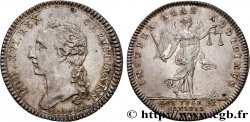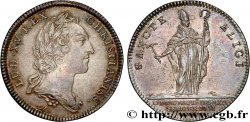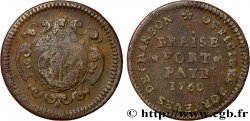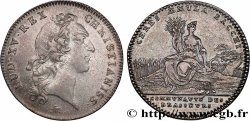fjt_261039 - CORPORATIONS MARCHANDS TEINTURIERS - REFRAPPE n.d.
Not available.
Item sold on our e-shop (2012)
Price : 20.00 €
Item sold on our e-shop (2012)
Price : 20.00 €
Type : MARCHANDS TEINTURIERS - REFRAPPE
Date: n.d.
Metal : silver
Diameter : 31 mm
Orientation dies : 12 h.
Edge : lisse
Rarity : R1
Catalogue references :
Predigree :
Cette refrappe provient de la collection Pierre-Yves Lathoumétie
Obverse
Obverse legend : LOUIS. LE. GRAND. PROTECTEVR. DES. ARTS.
Obverse description : Tête de Louis XIV variante du type Guéant Prieur 444 H.
Reverse
Reverse legend : DE. TE. LUX. DE. LUCE. COLORES ; À L'EXERGUE : MARCHS. TEINTVS. DE. BON. TEINT..
Reverse description : Le soleil faisant pousser de fleurs.
Reverse translation : De toi la lumière, de la lumière les couleurs.
Commentary
Buste très surprenant, inédit au Guéant Prieur, reprenant une légende répertoriée, dont nous n’aurions que le témoignage sur cette refrappe.
Cette refrappe porte le n° 150 /500
Les métiers de la teinture se divisent sous l'ancien régime en trois catégories : les teinturiers de grand et bon teint, les teinturiers de petit teint et ceux de soie, laine et fil Les premiers, dont il est question ici, travaillent les belles étoffes avec les teintures les plus estimées, comme l'inde et la fleurée Les seconds usent de teintures médiocres, principalement celle dite "noir de chaudière ou moulée".
Refrappe certaine bien que le jeton soit sans poinçon. Ce type de refrappe a été fait pour collectionneurs et pour pallier à l’impossibilité de trouver certains jetons, rarissimes voire inconnus en frappe originale.
Cette refrappe porte le n° 150 /500
Les métiers de la teinture se divisent sous l'ancien régime en trois catégories : les teinturiers de grand et bon teint, les teinturiers de petit teint et ceux de soie, laine et fil Les premiers, dont il est question ici, travaillent les belles étoffes avec les teintures les plus estimées, comme l'inde et la fleurée Les seconds usent de teintures médiocres, principalement celle dite "noir de chaudière ou moulée".
Refrappe certaine bien que le jeton soit sans poinçon. Ce type de refrappe a été fait pour collectionneurs et pour pallier à l’impossibilité de trouver certains jetons, rarissimes voire inconnus en frappe originale.








 Report a mistake
Report a mistake Print the page
Print the page Share my selection
Share my selection Ask a question
Ask a question Consign / sell
Consign / sell
 Full data
Full data



